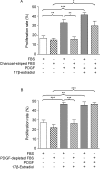Interdependence of platelet-derived growth factor and estrogen-signaling pathways in inducing neonatal rat testicular gonocytes proliferation
- PMID: 20089883
- PMCID: PMC2857630
- DOI: 10.1095/biolreprod.109.081729
Interdependence of platelet-derived growth factor and estrogen-signaling pathways in inducing neonatal rat testicular gonocytes proliferation
Abstract
We previously found that platelet-derived growth factor (PDGF) and 17beta-estradiol stimulate gonocyte proliferation in a dose-dependent, nonadditive manner. In the present study, we report that gonocytes express RAF1, MAP2K1, and MAPK1/3. Inhibition of RAF1 and MAP2K1/2, but not phosphoinositide-3-kinase, blocked PDGF-induced proliferation. AG-370, an inhibitor of PDGF receptor kinase activity, suppressed not only PDGF-induced proliferation but also that induced by 17beta-estradiol. In addition, RAF1 and MAP2K1/2 inhibitors blocked 17beta-estradiol-activated proliferation. The estrogen receptor antagonist ICI 182780 inhibited both the effects of 17beta-estradiol and PDGF. PDGF lost its stimulatory effect when steroid-depleted serum or no serum was used. Similarly, 17beta-estradiol did not induce gonocyte proliferation in the absence of PDGF. The xenoestrogens genistein, bisphenol A, and DES, but not coumestrol, stimulated gonocyte proliferation in a dose-dependent and PDGF-dependent manner similarly to 17beta-estradiol. Their effects were blocked by ICI 182780, suggesting that they act via the estrogen receptor. AG-370 blocked genistein and bisphenol A effects, demonstrating their requirement of PDGF receptor activation in a manner similar to 17beta-estradiol. These results demonstrate the interdependence of PDGF and estrogen pathways in stimulating in vitro gonocyte proliferation, suggesting that this critical step in gonocyte development might be regulated in vivo by the coordinated action of PDGF and estrogen. Thus, the inappropriate exposure of gonocytes to xenoestrogens might disrupt the crosstalk between the two pathways and potentially interfere with gonocyte development.
Figures






Similar articles
-
Regulation of rat testis gonocyte proliferation by platelet-derived growth factor and estradiol: identification of signaling mechanisms involved.Endocrinology. 1997 Mar;138(3):1289-98. doi: 10.1210/endo.138.3.5021. Endocrinology. 1997. PMID: 9048638
-
Prenatal exposure to estrogenic compounds alters the expression pattern of platelet-derived growth factor receptors alpha and beta in neonatal rat testis: identification of gonocytes as targets of estrogen exposure.Biol Reprod. 2003 Mar;68(3):867-80. doi: 10.1095/biolreprod.102.009605. Biol Reprod. 2003. PMID: 12604637
-
Role of retinoic acid and platelet-derived growth factor receptor cross talk in the regulation of neonatal gonocyte and embryonal carcinoma cell differentiation.Endocrinology. 2015 Jan;156(1):346-59. doi: 10.1210/en.2014-1524. Endocrinology. 2015. PMID: 25380237 Free PMC article.
-
The novel estrogen receptor, G protein-coupled receptor 30, mediates the proliferative effects induced by 17beta-estradiol on mouse spermatogonial GC-1 cell line.Endocrinology. 2008 Oct;149(10):5043-51. doi: 10.1210/en.2007-1593. Epub 2008 Jun 19. Endocrinology. 2008. PMID: 18566133
-
Platelet-derived growth factor. Distinct signal transduction pathways associated with migration versus proliferation.Ann N Y Acad Sci. 1995 Sep 7;766:416-30. doi: 10.1111/j.1749-6632.1995.tb26691.x. Ann N Y Acad Sci. 1995. PMID: 7486687 Review.
Cited by
-
Estrogens in male germ cells.Spermatogenesis. 2011 Apr;1(2):90-94. doi: 10.4161/spmg.1.2.16766. Spermatogenesis. 2011. PMID: 22319655 Free PMC article.
-
Studies in experimental autoimmune encephalomyelitis do not support developmental bisphenol a exposure as an environmental factor in increasing multiple sclerosis risk.Toxicol Sci. 2013 Sep;135(1):91-102. doi: 10.1093/toxsci/kft141. Epub 2013 Jun 23. Toxicol Sci. 2013. PMID: 23798566 Free PMC article.
-
Regulation of germ line stem cell homeostasis.Anim Reprod. 2015 Jan-Mar;12(1):35-45. Anim Reprod. 2015. PMID: 28286576 Free PMC article.
-
A new molecular subclassification and in silico predictions for diagnosis and prognosis of papillary thyroid cancer by alternative splicing profile.Front Pharmacol. 2023 Mar 6;14:1119789. doi: 10.3389/fphar.2023.1119789. eCollection 2023. Front Pharmacol. 2023. PMID: 36950012 Free PMC article.
-
Role of the Ubiquitin Ligase RNF149 in the Development of Rat Neonatal Gonocytes.Front Endocrinol (Lausanne). 2022 May 13;13:896507. doi: 10.3389/fendo.2022.896507. eCollection 2022. Front Endocrinol (Lausanne). 2022. PMID: 35634494 Free PMC article.
References
-
- McGuinness MP, Orth JM.Reinitiation of gonocyte mitosis and movement of gonocytes to the basement membrane in testes of newborn rats in vivo and in vitro. Anat Rec 1992; 233: 527–537. - PubMed
-
- Vergouwen RP, Jacobs SG, Huiskamp R, Davids JA, de Rooij DG.Proliferative activity of gonocytes, Sertoli cells and interstitial cells during testicular development in mice. J Reprod Fertil 1991; 93: 233–243. - PubMed
-
- de Rooij DG, Russel LD.All you wanted to know about spermatogonia but were afraid to ask. J Androl 2000; 21: 776–798. - PubMed
-
- Li H, Papadopoulos V, Vidic B, Dym M, Culty M.Regulation of rat testis gonocyte proliferation by platelet-derived growth factor and estradiol: identification of signaling mechanisms involved. Endocrinology 1997; 138: 1289–1298. - PubMed
-
- Hoch RV, Soriano P.Roles of PDGF in animal development. Development 2003; 130: 4769–4784. - PubMed
Publication types
MeSH terms
Substances
Grants and funding
LinkOut - more resources
Full Text Sources
Research Materials
Miscellaneous

